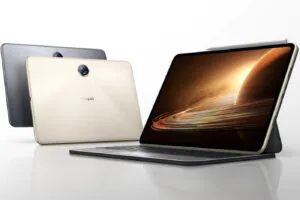
OPPO recently launched its latest flagship smartphone lineup, the Find X6 series, and along with it, announced the OPPO Pad 2. The new tablet brings specs and a design that looks oddly similar to the recently-unveiled OnePlus Pad.
The OPPO Pad 2 boasts an 11.61-inch 2800×2000 LCD display with a high 144Hz refresh rate, a peak brightness of 500 nits, as well as a tall 7:5 aspect ratio. For the multimedia experience, the tablet comes with four speakers and supports both Dolby Vision and Dolby Atmos. As for security, it does not have a fingerprint sensor, but it does offer face unlocking.

MediaTek’s flagship chipset from 2021, the Dimensity 9000 SoC, runs everything under the hood. The chip is paired with between 8GB and 12GB of LPDDR5 RAM and can be configured with between 256GB and 512GB of UFS 3.1 storage. Unfortunately, it does not have a microSD slot for storage expansion.
Moving on to the camera system, the OPPO Pad 2 features the same setup as its predecessor. It packs a 13MP camera with autofocus in the back while up front, it houses an 8MP sensor with a fixed focus.

The new OPPO tablet is powered by a much larger battery than last year’s model, fitting in a 9,510mAh battery compared to the original Pad’s 8,760mAh capacity. Moreover, the charging speed has doubled from 33W to 67W.
Connectivity-wise, the Pad 2 supports up to Wi-Fi 6 and Bluetooth 5.3, but there is no cellular version. It ships with ColorOS 13.1 based on Android 13 and comes in grey and cold colour options.
The OPPO Pad 2 starts from CNY2,999 (~RM1,940) for the base model with 8GB of RAM and 256GB of storage, while the maxed-out variant with 12GB of RAM and 515GB of storage is priced at CNY3,999 (~RM2,588). Currently, it is only coming to China and the company has not announced its availability in other markets.
(Source: OPPO, GSMArena)
The post OPPO Pad 2 Officially Launches With 11.6-Inch Display, 144Hz Refresh Rate appeared first on Lowyat.NET.
